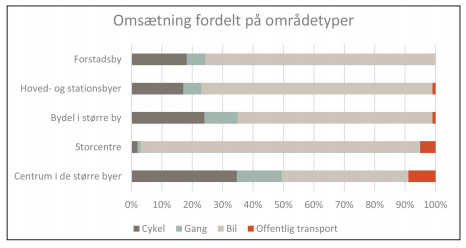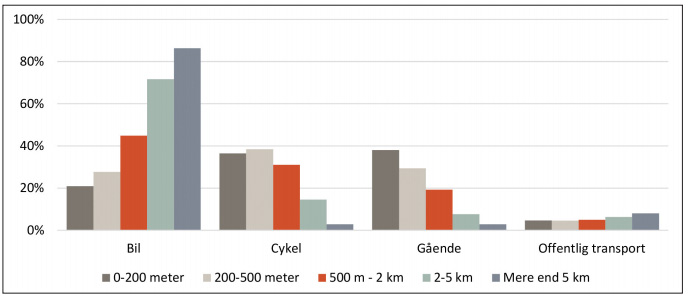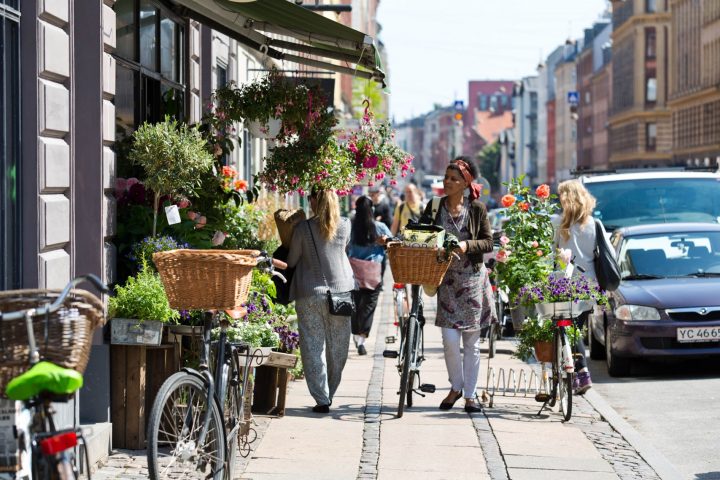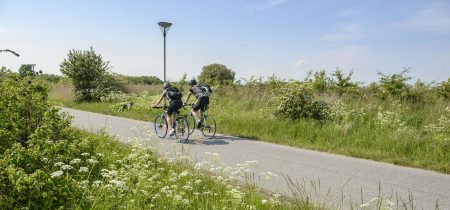Cycling and shopping
The connection between cycling and shopping is important, because cycling infrastructure prioritization can mean a reduction in need for parking spaces. Several cities in Denmark and abroad have analysed the actual turnover depending on whether the shopper arrives on foot, by public transport, by car, or by bike.
By Anna Garrett, The Office for Cycle Superhighways
Copenhagen cyclists are good, loyal consumers
Copenhagen is one of several cities who have investigated the relationship between the turnover in shops and the transport mode used for shopping. The results are that shoppers arriving by bike or on foot are together responsible for almost 50% of the turnover in shops in Copenhagen (29% and 20% respectively). Drivers are responsible for 36% and public transport users for 15%.
When it comes to street level shops the turnover from drivers and cyclists is about the same, approx. DKK 15 billion annually for each group. The report shows that drivers only create greater turnover in shopping centers. Almost half of the shopping trips by car are carried out by non-residents of the City of Copenhagen. Cyclists are also more loyal customers and shop far more often in the same shops than drivers, which indicates that shops would do well to invest in bike friendly facilities.
The denser the city, the greater the cyclist share
Annual turnover in Copenhagen
- DKK 22 billion by car
- DKK 18 billion by bike
- DKK 12 billion on foot
- DKK 9 billion by public transport
A similar study of different types of city with different transport habits was carried out by COWI in several other Danish municipalities. The results show the same pattern in the large city centers as in Copenhagen. Cyclists and walkers are responsible for half the turnover, whereas in the small and medium sized cities they are responsible for roughly a quarter of the turnover. The bicycle is the transport mode of choice in central city areas, and cyclists generally visit more shops per trip than drivers.

- Figure 1: Distribution of the turnover in different area types according to transport type. From above: Suburban town. Capital and railway town. Larger city neighborhood. Shopping center. Larger cities’ city center. From the left: Cycling, walking, cars, public transport.
Typical reasons for not shopping by bike:
The primary reasons given for not shopping by bike even though you have one, but choosing a car for the trip instead:
- The distance is too great
- Too many goods to transport
- Transport of heavy goods
- Other errands that can’t be combined with cycling
- Didn’t feel like cycling
Cyclists visit more shops whereas drivers spend more money per trip
A cyclist generates an average DKK 410 per trip compared to DKK 644 per trip for a driver. In the city center of the larger cities the figures are DKK 500 per cyclist trip and DKK 734 per driven trip. Cars are primarily used to transport staple goods and other commodities that need to be transported home. Cycling and public transport on the other hand are the transport mode of choice for personal care or experiences.
When questioned about the number of shops, experience or service offers the consumer has visited per trip, cyclists generally visit more than drivers. In the larger towns the figure is more or less the same for the two road user groups, whereas there are significant differences between cyclists and drivers when it comes to shopping centers and shopping in the main cities. Drivers tend to drive to only one shop to do business whereas cyclists go to several shops per trip, or combine a trip to the dentist with shopping in the city’s shops.

- Figure 2: Distribution of consumers according to transport type and distance between home and the closest shop where most staple goods are available.
Sources:
Incentive 2012 og 2014: Indkøb og transportvaner i København
COWI 2015: TRANSPORT, FORBRUG OG ADFÆRD EN UNDERSØGELSE AF DANSKERNES HANDELSLIV (7 jyske og fynske kommuner)
COWI 2016: TRANSPORT, FORBRUG OG ADFÆRD EN UNDERSØGELSE AF DANSKERNES HANDELSLIV (4 sjællandske kommuner)
Celis og Nielsen 2016: Cyklister er guld værd for byerne, i Trafik og Veje juni/juli 2016






